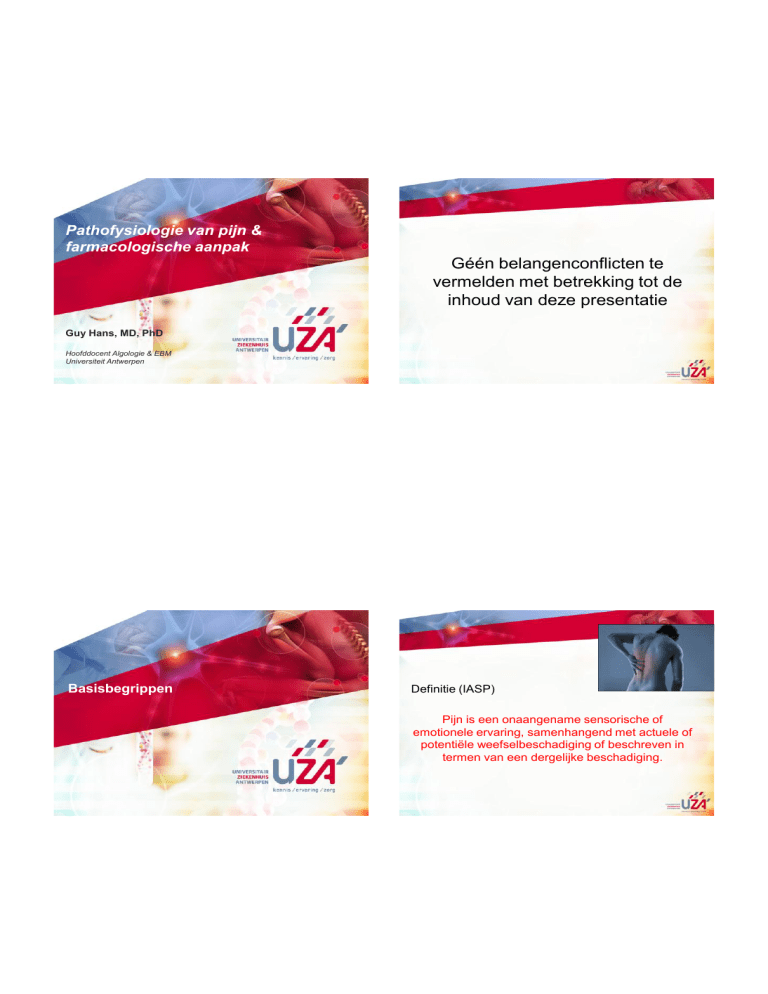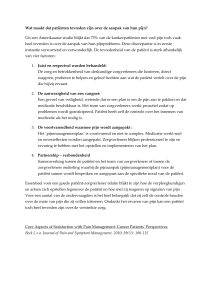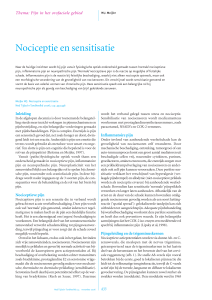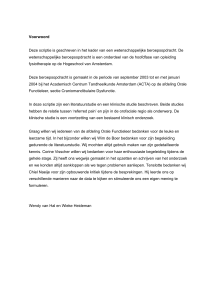
Pathofysiologie van pijn &
farmacologische aanpak
Géén belangenconflicten te
vermelden met betrekking tot de
inhoud van deze presentatie
Guy Hans, MD, PhD
Hoofddocent Algologie & EBM
Universiteit Antwerpen
Basisbegrippen
Definitie (IASP)
Pijn is een onaangename sensorische of
emotionele ervaring, samenhangend met actuele of
potentiële weefselbeschadiging of beschreven in
termen van een dergelijke beschadiging.
Acute vs. Chronische pijn
• Acute Pijn
• Chronische Pijn
– Korte duur
– Protectieve (biologische)
functie
• Beschermt het lichaam tegen
beschadiging
– Aanwezigheid van een letsel
•
•
•
•
•
Wonde
Brandwonde
Fractuur
Weefselbeschadiging
...
Algemene Doelstellingen
• “Vermindering” van pijnklachten
– Farmacologisch - invasief
– Ondersteunend
– Lange duur
• > 3 (6) maanden
– Geen protectieve functie
• Geen bescherming
tegen beschadiging
– Vaak kan geen
anatomisch letsel meer
aangetoond worden
•
•
•
•
Verbetering van functionaliteit
Reductie co-morbiditeit
Reïntegratie in socio-economisch milieu
Stopzetting van „medical shopping‟
• Tijdelijke dysfunctie ?
Fysiologie van pijn
• Transductie
– Activatie Nociceptoren
– Nociceptieve stimuli
Fysiologie & Pathofysiologie
• Transmissie
– Voortgeleiding impulsen
• Dorsale hoorn
• Hersenen
• Modulatie
– ↓↓ of nociceptieve
impulsen (dorsale hoorn)
• Perceptie
C
Nociceptors
Aδ
Myelination
low
no
Diameter
±4µ
±1 µ
NCV (m/s)
± 10
±1
Thermal threshold (°C)
± 45
± 40
Skin depth (µm)
20-500
20-500
Density (n/mm2)
<2
4-8
Receptor field (mm2)
200
20
Polymodal (Mechano-Heat)
sensit.
yes
Spinal projection spinal
I
I-IIa,b
Opiate receptors
-
+++
Peptides
-
- /+++
Sensory qualities
pricking burning
localised diffuse
Nolano et al., 1999
brief
prolonged
“first”
“second”
Pain Processing in Spinal Cord
Inhibitory
Interneuron
Primary Afferent
Nerve Fiber
Glu
Glu
SP
SP
Glu
Glu
Glu
SP
Mg++
Spinal Sensory Neuron
Glu
AMPA
Receptor
SP
GLY
-
NMDA
Receptor
NK-1
Receptor
Na+
Ca++
Glycine
Receptor
Second Messenger
Formation
Spinal Cord Neuron
Copyright
R. Sinatra MD
2002
4 Sensations are perceived
in the primary somatic
sensory cortex.
4
3 Sensory pathways
synapse in the thalamus.
3
THALAMUS
2
2
Fine touch, vibration,
and proprioception
pathways cross the
midline in the medulla.
1
1
Pain, temperature, and
coarse touch cross the
midline in the spinal cord.
KEY
Thalamus
Anterior
Crude touch and
spinothalamic pressure
Dorsal root
ganglion
Posterior horn
Thalamus
Medulla
oblongata
Thalamus
Primary sensory
cortex (opposite
side)
Medulla
oblongata
Thalamus
Primary sensory
cortex (opposite
side)
Posterior horn
Not present Cerebellar cortex
Proprioception, fine Dorsal root
touch and pressure ganglion
from superior half of
the body
Spinocerebellar pathway
Anterior and Proprioception
posterior
Primary sensory neuron
Secondary sensory neuron
Tertiary neuron
SPINAL CORD
Dorsal root
ganglion
Descending control of pain
Figure 12.8a
3rd order
Posterior horn
Fasciculus
cuneatus
Fine touch,
proprioception,
vibration
2nd order
Dorsal root
ganglion
Posterior column pathway
Fasciculus
Proprioception, fine Dorsal root
gracilis
touch and pressure ganglion
from inferior half of
the body
MEDULLA
Nociception,
temperature,
coarse touch
1st order
Pathway
Sensation
Spinothalamic pathway
Lateral
Pain and
spinothalamic temperature
Final destination
Primary sensory
cortex (opposite
side)
Primary sensory
cortex (opposite
side)
Nociceptief insult …
Sensitivity before and after a burn lesion (53°C
30 s.)
Primaire Hyperalgesie
Molecular complexity of primary nociceptors
reponse to inflammatory mediators at the site of injury
Sensitizatie: perifeer naar centraal
Tissue Injury
• Neurogene inflammatie
Repetitive Stimulation of A-delta-fibers and C-fibers
– Perifere sensitizatie
• productie prostanoiden ter hoogte van weefselbeschadiging
• inductie COX-2
– Activatie macrofagen (binnen ruggenmerg)
» Vrijzetting cytokines en chemokines
» Interactie op neuronen en gliale cellen
» Allodynie + Hyperalgesie
• Slecht gecontroleerde en/of langdurige pijn
– Inhiberende functie thv. antinociceptief systeem
Progressive Increase in Action Potentials
Prolonged Increase in Spinal Cord Excitability
Neurochemical-Anatomical Alterations
Leading to Persistent Pain
Microglial
Cells
Interneuron
Cell Death
Interneuron
Synaptic
Removal
Primary Afferent
Nerve Fiber
NO, PG
NO,
PG
Glu
A-fiber
Connections
PG
PG
+
sP
NMDA
+
COX-2
PGE2, PGI2
NO
NOS
Aracadonic Acid
PG
Inflammation
Hyperexcitability
Toxicity?
Glu
Axon
Sprout
NO
NO
Nitric Oxide
Ca++
2nd Messengers, (IP, PK, cGMP)
Spinal Sensory Neuron
Genome Activation, RNA& Protein Synthesis,
Hyperexcitability, Toxicity
Secundaire Hyperalgesie (1)
• AMPA receptoren
– Na+ en K+ kanalen
• Dorsale hoorn neuronen
– Activatie door glutamaat
• NMDA receptoren
– Langdurige activatie AMPA
• Wijziging rustpotentiaal membraan
• Verwijdering Mg2+ plug op NMDA-R
• NMDA-R ontvankelijk voor activatie door glutamaat
– Centrale sensitizatie (wind-up)
• Gestoorde balans neurotransmitters, synthese gen proteïnen,
veranderingen in receptor binding en activatiedrempel zenuwen,
vorming nieuwe synapsen, apoptosis, …
Copyright
R. Sinatra
MD, 2002
Secundaire hyperalgesie (2)
• Klinische gevolgen NMDA activatie
– ↓ activatiedrempel zenuwstrukturen
• Hyperalgesie
– A-vezels betrokken bij pijngeleiding
• Allodynie
– ↓ activatiedrempel µ-opioid receptoren
• ↓↓ werkzaamheid endogene/exogene opioiden
• Tolerantie aan opioiden
• nood aan antinociceptive inhibitie
– ↓ gevoeligheid voor catecholamines
• Facilitatie transmissie pijnsignalen
– Uitbreiding sensitizatie naar
nabijgelegen neuronen in ruggenmerg
• Niet-dermatosomale verspreiding
Diagnostiek … waar te beginnen?
• Identificatie van Nociceptief Syndroom
Diagnose … !!
– Spontane + Geïnduceerde Nociceptie
– Kwantitatieve en objectieve meting van sensoriële functie en
perceptie van pijn
• Intra-individuele verschillen
– Vergelijking met normatieve data!
• Opvolging over tijd
– Evaluatie therapie
– Identificatie van pijn-Type
• Nociceptief
– Somatisch
– Visceraal
• Neuropathisch (niet-nociceptief)
Klinisch beeld (1)
• Stimulus-uitgelokte (dependente) afwijkingen …
– Allodynie (+)
• Niet pijnlijke stimulus lokt nu wel hevige pijn uit
– Analgesie (-)
• Geen gewaarwording van pijn op normaal pijnlijke stimulus
– Hyperalgesie (+)
Klinisch beeld (2)
• Meer aandacht voor onderliggende
pathofysiologische mechanismen
– Ipv. aandoening-gebaseerd
– Behandeling gericht op pathofysiologie
• Verhoogde pijngewaarwording op normaal weinig pijnlijke stimulus
– Hyperesthesie (+)
• Verhoogde gevoeligheid op verschillende stimulaties
– Hyperpathie (+)
• Abnormaal pijnlijke reactie op herhaalde stimulatie (verhoogde drempel!)
– Hypoalgesie (-)
• Verminderde pijngewaarwording op pijnlijke stimulus
– Hypoesthesie (-)
• Globaal verminderde gevoeligheid op stimulaties allerhande
• Op dit ogenblik echter vaak (nog) niet mogelijk om
specifiek pathologisch mechanisme bij individuele
patiënt te duiden
• Perifere en centrale mechanismen
• Verschillende contributie resulteert in kwalitatief
uiteenlopende pijnsyndromen
Elke patiënt is verschillend … !
3 subtypes of PHN patients
• Prominent allodynia + minimal sensory deficits
– Central sensitization, maintained by abnormal
activity in primary afferent nociceptors (LA)
• Spontaneous pain, little or no allodynia + marked
sensory deficits in the areas of greatest pain
– Central hyperacitivity resulting from deafferentiation
• Both sensory deficits and allodynia
– Deafferentiation accompanied by central
reorganisation
» Sprouting of large myelinated fibers into
substantia gelatinosa
Perifere
sensitizatie
Ectopische
ontladingen,
spontane
activiteit
Chronische Pijn
Sympathetisch
afferente
koppeling
Centrale
sensitizatie
• Identificatie van pijnsyndromen volgens
Corticosteroiden
Perifere
NSAIDS
Sensitizatie
Lidocaine topic
Carbamazepine
Ectopische
Gabapentin
ontladingen,
spontane
activiteit
Postoperative
Chronische
Pijn
Neuralgie
•
Sympathische
afferente
Sympathetische
koppeling
blocks
Centrale
Opioids
sensitizatie
Antidepressants
NMDA antag.
–
–
–
–
Symptomen (sensorieel!)
Klinische tekens
Kwantitatief sensorieel onderzoek
Respons(en) op farmacologische trials
– Snelle screening (tools)
– Risico-inschatting op chronificatie
• Pre-operatief
– Aanpassing anesthesie
– Intensieve follow-up
Diagnostische Oppuntstelling (1)
• Functionele MRI (fMRI)
– Visualisatie van corticale activatie
• Centrale sensitizatie en wind-up
• Activatie van ZS op specifieke externe
stimulaties
Diagnostische Oppuntstelling (2)
• Kwantitatief Sensorieel Onderzoek (QST)
– Vibratie
– Mechanisch
– Thermaal
–
–
–
–
– Druk, temperatuur, chemische prikkels
• Therapeutische implicaties
– Neurostimulatie
» Somato-sensorische corticale stimulatie
– Specificiteit ???
•
•
•
•
Cold sensation
Warmth sensation
Cold pain
Heat pain
Kwantiatieve evaluatie
Kwalitatieve evaluatie
Predictieve waarde
Kan herhaald worden
Diagnostische Oppuntstelling (3)
• Geringe klinische toepassing …
– Tijdrovend (120min + 60 à 90 min)
– Uitrusting duur in aankoop
– Geen uniform protocol voor uitvoering
• Conditioned Pain Modulation
– Functionaliteit van descenderend inhiberend
systeem
– Dubbele thermale stimulatie (2 lichaamzones)
• Conditionerende stimulus
• Test stimulus
– Mate van effectiviteit van descenderende inhibitie (-)
– Hyper- en hypo-activiteit meting mogelijk
• Semi-kwantitatief onderzoek !
– Predictie / profylaxis / behandeling
Diagnostische Oppuntstelling (4)
• Kwantificering van pijn(intensiteit) …
– Autonome multiparameter evaluatie
• Photopletysmografie
– Amplitude en variatie in amplitude
Behandeling
• Huidweerstand (fluctuaties)
• Hartfrequentie
– Variabiliteit
– Intervaltijd
– Patiënt-specifieke “pijn-index”
• Continue opvolging tijdens operatie/revalidatie
• Opvolging tijdens behandeling
• Gekoppeld aan QST onderzoeken
Algemene richtlijn
Multimodal Analgesia
• Multimodaal
– Polyfarmaceutisch beleid
– Neuromodulatie
– Levenshygiëne (oa.voeding)
• Intensieve opvolging patiënt
• Multidisciplinariteit
5. Perception
Opioids, Paracetamol,
Clonidine, Ketamine,
Gabapentin, Tricyclics
6. CNS Responses
Muscle Relaxants,
Beta Blockers
1. Transduction
4. Modulation
NSAIDS, COX-2 Inhibitors,
Anti-Histamines, Topical
Local Anesthetics
Opioids,
Clonidine,
COX-2 Inhibitors
-
• One size does not fit all
-
PAIN
2. Conduction
– Subtypering !!
Peripheral Nerve Block
Local Anesthetics
Copyright R. Sinatra MD.2002
3. Transmission
Epidural Block
Local Anesthetics
Perifeer Zenuwstelsel (1)
• Locale anesthetica
– Blokkade Na+-kanalen in neuronale membranen
– Lidocaine 5% pleister (Versatis®)
• Terugbetaling voor PHN
– Andere perifere neuropathische pijnsyndromen
• Naast perifere, ook centrale werking (dewinding?)
– Selectieve infiltratie van perifere zenuwstrukturen
• Echografie
• Selectieve behandeling mogelijk (diagnose !)
– Proximaal van „plaats van beschadiging‟
• Weinig belastend voor patiënt
• Nieuwe mogelijkheden voor RF-behandeling ...
– Onvoldoende lange-termijn effecten ...
Perifeer
Zenuwstelsel (2)
• Capsaicine (Qutenza®)
–
–
–
–
Perifere neuropathie
Applicatie 30 – 60 min
3 maanden analgesie
Quid lange-termijn ?
• Neurodegeneratieve veranderingen (perifeer + centraal)
– ↓ efficaciteit synaptische transmissie dorsale hoorn
• NSAID
– Inhibitie van cyclooxygenase enzyme
• ↓↓ vrijzetting inflammatoire mediatoren (PG)
– Neveneffecten !!
– Topical applicatie … ?
Electro-Therapie
• TENS
– Pijn-reducerende stromen
• Milli-ampère
– „Poort‟ theorie + vrijzetting van Endorphines
• -ampère stroom (MET)
– intensiteit
– puls-lengte
• in vergelijking met TENS
• Langduriger effect ( dagen)
– Weefselherstel
• ATP-productie, transport van aminozuren
– Acute, chronische, post-heelkundige/trauma
• TSE (Transcutaneous Spinal Electro-analgesia)
– Veralgemeende pijnsyndromen (widespread pain)
Opioiden
• Verschillend klinisch profiel naargelang receptor interactie
• Buprenorfine, methadon
• Morphine, fentanyl, sufentanil, oxycodone, hydromorfone
• Tapentadol
2 ligands (Ca2+)
MOR-NRI
• Tweevoudig werkingsmechanisme
– µ-opioid receptor
– heropname NA
• Vgl. Venlafaxine in diermodellen
• Werkzaamheid nociceptieve pijn
– Vergelijking met oxycodone
• Quid neuropathische pijn !?
– DPN
• GI neveneffecten
• Binding subeenheid van voltageafhankelijke Ca2+ kanalen op
neuronale membranen
– ↓↓ excitatoire neurotransmitters
• Activatie descenderende
inhiberende banen
– NA concentratie spinaal
– Nausea, obstipatie en braken
• tolerantie
• Quid cardio-vasculair ?
• Gabapentine, pregabaline
Descenderende inhibitie
• 2(A)-adrenoreceptor agonisten
– Clonidine
– Dexmedetomidine
• Grotere selectiviteit 1620:1 (vs. 300:1)
• T1/2: 2 à 3 uur
• Essentiële rol in
descenderende pijnmodulatie
– Stimulatie veralgemeende analgesie
• Locus coeruleus
• Parabrachiale nucleus in medulla
– G-proteïne gemedieerde K+ kanalen
Therapeutische infusies
• Intraveneuze lidocaine
Dosis...?
– Effectief in syndromen gekenmerkt door
• Sensitizatie
• prikkelbaarheid van nociceptieve afferenten
• Mechano-insensitieve nociceptoren (hyperalgesia)
• perifere vrijzetting van mediatoren
– Toediening onder continue hemodynamische monitoring
• (inductie-dosis) + onderhoudsdosis
– Langdurige analgesie
• Individueel grote verschillen in analgetische respons (intensiteit én duur)
• Intraveneuze ketamine
– Effectief bij wind-up/sensitizatie fenomenen
– Mogelijke neveneffecten !
• Toevoeging van benzodiazepines
– Orale (langdurige) behandeling moeilijk uitvoerbaar
“Corticale” Sensitizatie
• TCA‟s
– “7 farmaca in één”
• Serotonin reuptake inhibitoren
• Norepinephrine reuptake inhibitoren
• Anticholinerge-antimuscarine farmaca
• Alpha-1 adrenerge antagonisten
• Antihistaminica
• Opioid-achtige effecten
• Locale anesthetica
• (SSRI‟s)
• SNRI‟s
– Venlafaxine (Efexor®)
– Duloxetine (Cymbalta®)
Autonome Dysregulatie
Conclusie
• Complex Regionaal Pijnsyndroom (CRPS)
Multimodale en Multidisciplinaire
therapeutische aanpak
– Farmacologische behandelingsmogelijkheden
– Interventionele R/ thv. sympathische ganglia
• Locale anaesthetica thv. sympathetische paravertebrale ganglia
• Regionale intraveneuze behandeling (sympathicolysis)
– Guanethidine (beschikbaarheid!?)
– Locale anaesthetica
– Heelkundige sympathectomie
• Zeer beperkte evidentie !
Farmacotherapie
Reëducatie
Interventionele
behandelingen
Reïntegratie
Psychotherapie
– Risico op uitgesproken oedeem
» Blijvende overgevoeligheid
– Fysiotherapie (beweging)
• Uitermate belangrijk !
• Aangetoond effect op lange-termijn
– pijn en actieve mobilisatie
» Lymfe-drainage: géén voordeel
– Psychologische behandeling ( fysiotherapie)
• Langdurige symptomatologie
Revalidatie
(Reactivatie)







